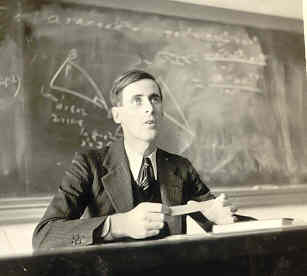Van Stockum's cylinder
© Miracle StudiosMass and energy act on space-time like a rock thrown into a pond: the bigger the rock, the bigger the ripples. Physicist W.J. van Stockum realized in 1937 that an immense cylinder spinning at near-light speed will stir space-time as though it were molasses, pulling it along as the cylinder turns. Although Van Stockum himself didn't recognize it, anyone orbiting such a cylinder in the direction of the spin will be caught in the current and, from the perspective of a distant observer, exceed the speed of light. The result: Time flows backward. Circle the cylinder in the other direction with just the right trajectory, and this machine can take you into the future as well.
Michio Kaku, in Wired Magazine.As pointed out by Andrzej Krasinski, it was the Hungarian scientist Kornel (Cornelius) Lanczos who first derived the exact solution of Einstein's equation of gravitation with rotating matter (although he may have been unaware of its rotation). Lanczos's paper (reprinted recently) is from 1924, but apparently Van Stockum did not know about this earlier work.
1905 Albert Einstein: a rocket is a time machine to the future 1937 W.J. van Stockum: time loop outside a rotating cylinder 1948 Kurt Gödel: time loop in a rotating universe 1963 Roy Kerr: time loop in a rotating black hole 1974 Frank Tipler: Van Stockum's cylinder is a time machine to the past 1989 Kip Thorne: wormhole time machine 1991 Richard Gott: cosmic string time machine Last year (2003) I reviewed some books on time travel for our University news paper. One of these was »How to build a time machine« by Paul Davies. It contains a time line like the one shown here. What struck me was that the time travel pioneers are all listed with their first name, except one: W.J. van Stockum. The book has illustrations of most of these pioneers, but not of Van Stockum. A search of the internet returned many links to Van Stockum's cylinder as the first time machine based on general relativity, but no clue on what "W.J." stood for. Was it a man or a woman?
I was curious. The name "Van Stockum" is Dutch, but the article from 1937 in which he (she?) reported the solution of Einstein's equation for a rotating cylinder lists Edinburgh as affiliation. One "Willem Jacob van Stockum" did his Ph.D. in Leiden in 1888, which seemed too early and moreover it was a thesis in the medical school. This could not be our W.J. I gave up and mentioned this little biographical puzzle in my book review.

There is only one reason why a man will throw himself into mortal combat and that is because there is nothing else to do and doing nothing is more intolerable than the fear of death. I could stand idly by and see every painting by Rembrandt, Leonardo da Vinci and Michelangelo thrown into a bonfire and feel no more than a deep regret, but throw one small, insignificant Polish urchin on the same bonfire and, by God, I'd pull him out or else. I fight quite simply for that and I cannot see what other reasons there are. At least, I can see there are reasons, but they are not the reasons that motivate me.
A soldier's creed by a bomber pilot, Willem Jacob van Stockum (1910-1944).Almost half a year had passed, when I was contacted by Erwin van Loo, a historian with the Royal Netherlands Air Force who is researching the role of Dutch pilots in the British R.A.F. He had read my book review and knew a W.J. van Stockum who matched the criteria. The name is indeed Willem Jacob van Stockum, just like the doctor from Leiden who was his uncle. Born in 1910 in Hattem, The Netherlands, died in 1944 in Laval, France. The military records briefly describe the circumstances of his death:
June 10, 1944: Take-off 0030 Melbourne to bomb the airfield. Shot down by flak, crashing at Entrammes (Mayenne) roughly 9 km SE of Laval and some 4 km from the airfield. Flying officer Van Stockum hailed from a Dutch family, his father, Col. A.J. van Stockum, having served in the Royal Netherlands Navy. Van Stockum was a brilliant scholar, having gained a BA and Large Gold Medal from Trinity College Dublin and an MA from Toronto University and a Ph.D. from Edinburgh University.Read more about Willem van Stockum's family.
...or about his career as a pilot.Carlo Beenakker --- with thanks to Erwin van Loo, Royal Netherlands Air Force